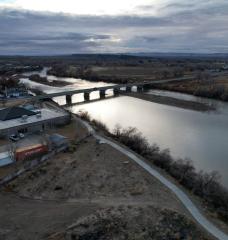
Oorja Energy, winners of the “Commercial and Industrial Energy Efficiency 2018” Climate CoLab contest, developed a pitch for a structural cooling system. India, where Oorja Energy is based, has intensely hot summers due to its tropical climate, and the infrastructure in India is not conducive to shielding people from this heat. In citing the inspiration for this project, Managing Director Madhusudhan Rao comments, “since we do not directly interact with the ambient or solar radiation when inside a building, we started looking at the role of building structure in transmitting this heat to the indoors.”
In India, thermal mass accumulates in buildings due to structural issues. The main problem is the use of concrete in construction, which traps heat inside buildings, even during non-solar hours. A secondary problem is the use of individual, energy-inefficient AC units as a substitute for building design that allows for temperature maintenance. Through simulation models and thermographic studies, Oorja determined that structural interventions on buildings would address air conditioning needs pragmatically and sustainably.
The design outlined by Oorja incorporates a network of pipes, that circulates cool water throughout the building. The water is cooled using a 2-stage cooling tower and his circulation removes heat trapped within the building structure. The pipes used in this design are specially grade pipes, that will be planned out and installed in direct correlation with the heat loads and airflow patterns of the buildings. In addition to the pipe network, fans are installed to improve airflow. Oorja’s model is informed by India’s rapid industrialization and growing economy. It seeks to embed energy efficient design within the infrastructure of new businesses and buildings.
Traditional air conditioning units use 1.2 KW per ton of cooling, compared to the energy-efficient Oorja method which uses 0.05 KW per ton. They estimate that within 10 years, the impact will be a decrease in around 40 million tons of CO2 emissions. In addition to economic savings and the environmental benefits of this approach, Oorja speculates that public health will improve based on deceased emissions. Rao’s interest in this project also stems from personal experience. He states, “I grew up in a coal town in India and have been witnessing the increase in capacity of the power plant from my childhood. A good chunk of this increase in capacity will be due to increase in air conditioning and industrial growth. All this increase in power generation capacity has wrecked environmental havoc in the coal towns across the country.” In light of India’s industrialization, Oorja’s structural design proposals can address a multitude of the issues brought on by climate change.
Oorja is collaborating with architects, HVAC designers, government officials, and real estate developers to fulfill their vision. Reflecting on their Climate CoLab win, Rao states, “the best thing to come out of our participation in the contest is the recognition that being a winner gives. It has given our solution more credibility and opened more doors for us”. Rao comments further, stating, “We are looking towards investor interest in our solution and our firm to help us scale up our offering in major way. Our current focus is markets in India as we feel this is where the solution holds most potential--though it has potential in other tropical countries.” Areas of interest include Egypt, Morocco, Kenya, and Nigeria. You can learn more about Oorja and the work they're doing in India here.






